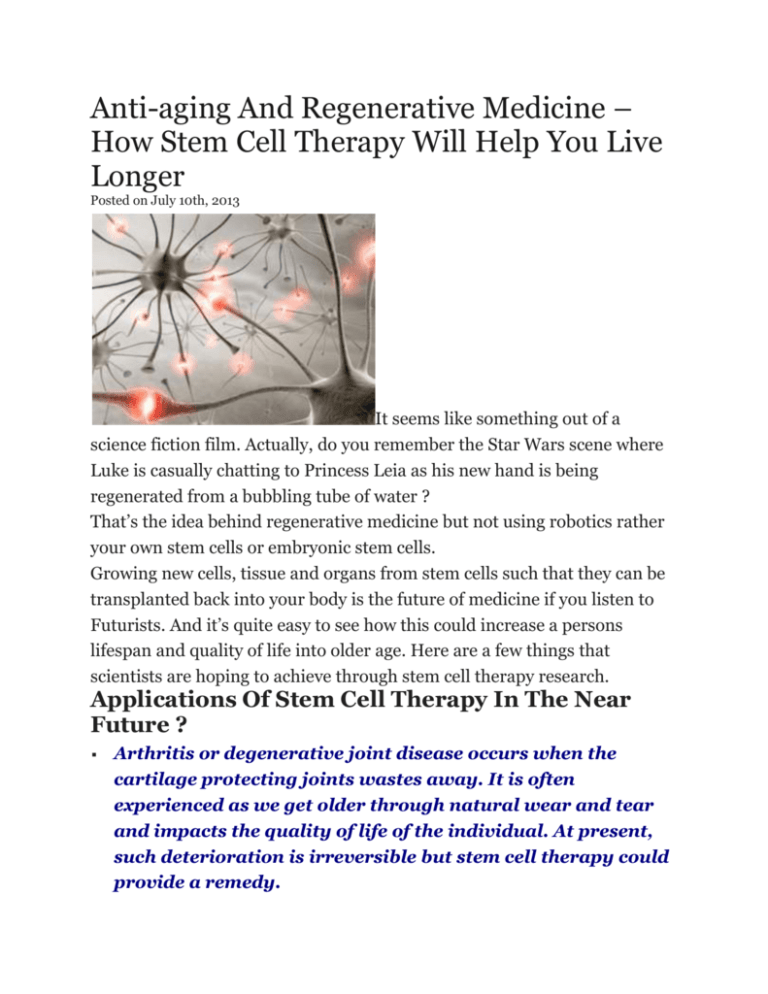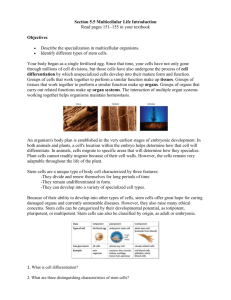How Stem Cell Therapy Will Help You Live Longer
advertisement

Anti-aging And Regenerative Medicine – How Stem Cell Therapy Will Help You Live Longer Posted on July 10th, 2013 It seems like something out of a science fiction film. Actually, do you remember the Star Wars scene where Luke is casually chatting to Princess Leia as his new hand is being regenerated from a bubbling tube of water ? That’s the idea behind regenerative medicine but not using robotics rather your own stem cells or embryonic stem cells. Growing new cells, tissue and organs from stem cells such that they can be transplanted back into your body is the future of medicine if you listen to Futurists. And it’s quite easy to see how this could increase a persons lifespan and quality of life into older age. Here are a few things that scientists are hoping to achieve through stem cell therapy research. Applications Of Stem Cell Therapy In The Near Future ? Arthritis or degenerative joint disease occurs when the cartilage protecting joints wastes away. It is often experienced as we get older through natural wear and tear and impacts the quality of life of the individual. At present, such deterioration is irreversible but stem cell therapy could provide a remedy. • In Type 1 Diabetes the pancreatic cells that make insulin are damaged so that the individual with the disease has to manually monitor his/her blood sugar level and inject insulin to regulate it. Type 1 Diabetes can also lead to other conditions such as poor circulation which has knock on effects to the extremities of the body. Stem cell research into this problem hopes to be able to repair the damaged pancreatic cells so that they can produce insulin or “grow” new pancreatic cells and transplant them into the individual. At present the studies being conducted involve human embryonic stem cells being transplanted on mice and results have been encouraging; the stem cells have successfully differentiated into insulin-producing, blood sugarregulating cells. Heart disease is a major killer of people in western, first world countries. Stem cell therapy research has injected stem cells into the heart to see if they may help regenerate damaged cardiac muscles. At present studies have shown optimistic results but so far test subjects have been limited to rodents. • In a fairly recent development, the Food and Drug Administration of the USA approved the use of embryonic stem cells in human beings as treatment for spinal cord injury. The main purpose of the treatments at this point is to ascertain the safety of such intervention but it is hoped that some test subjects will regain some sensation and some control over lower extremities Alzheimer’s disease is another illness where embryonic stem cells may provide significant progress. This disease, marked by memory loss, cognitive decline and behavioral problems is caused by the progressive degeneration of brain cells. Parkinson’s disease is a neurodegenerative disorder that causes tremors, stiffness and speech impairment. So far tests have been made on rodents exhibiting similar symptoms and results show that the introduction of embryonic stem cells has improved the motor function of test subjects. • Using human embryonic stem cells, researchers created transplantable lung sources which have the potential to repair damaged lung tissues. So far, studies using mice with acute lung injury have proved fruitful so there is a lot of optimism regarding the future use of stem cells for this purpose in humans. Lou Gehrig’s disease, more popularly referred to as amyotrophic lateral sclerosis or ALS is a debilitating disease which causes progressive and crippling damage to the brain and spinal cord neurons that control muscles. Prognosis is poor with patients dying in three to five years after diagnosis. Scientists are still studying ways to coax stem cells to differentiate into neurons. Apart from regenerating tissue and organs for a future transplant, researchers can also create the cells of a particular tissue or organ and study the effects of a disease in vitro. This means less need to experiment on animals and test possible drugs on animals. This could speed up the release of drugs that might slow down or cure many common and debilitating diseases.






